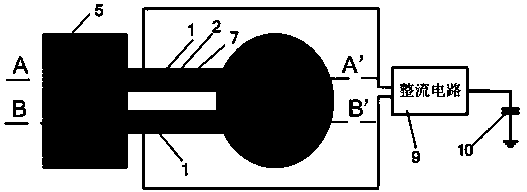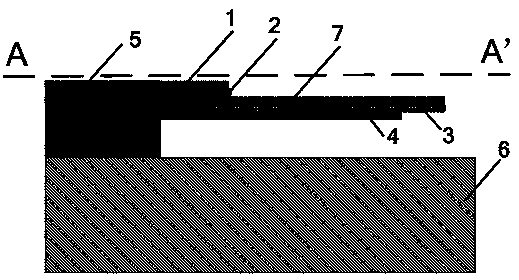Cantilever beam vibration and electromagnetism self-powered microsensor of Internet-of-things radio frequency transceiving assembly
A radio frequency transceiver, micro sensor technology, applied in piezoelectric devices/electrostrictive devices, electromagnetic wave systems, generators/motors, etc., can solve the problems of limiting the miniaturization of microsystems, limited long-term use time, large size and weight, etc. , to solve the problem of self-power supply, suppress jitter, increase inertial force and deformation
- Summary
- Abstract
- Description
- Claims
- Application Information
AI Technical Summary
Problems solved by technology
Method used
Image
Examples
Embodiment Construction
[0015] The specific implementation scheme of the cantilever vibration electromagnetic self-powered microsensor in the radio frequency transceiver component of the Internet of Things of the present invention is as follows:
[0016] On the gallium arsenide substrate 6 is provided: a MEMS cantilever beam, and a filter circuit 8 , a rectifier circuit 9 and an energy storage capacitor 10 are supplemented around the cantilever beam.
[0017] The MEMS cantilever beam consists of five layers, from top to bottom: upper electrode 1, piezoelectric film 2, lower electrode 7, silicon nitride dielectric layer 3 and rectangular microstrip patch antenna 4. The connection between the cantilever beam and the anchorage area is formed by two juxtaposed narrow beams, which together support the oval structure at the end. A cantilever beam is used to integrate two energy harvesting modules, a piezoelectric transducer and a rectenna system. The upper electrode 1, the lower electrode 7, and the recta...
PUM
 Login to View More
Login to View More Abstract
Description
Claims
Application Information
 Login to View More
Login to View More - R&D
- Intellectual Property
- Life Sciences
- Materials
- Tech Scout
- Unparalleled Data Quality
- Higher Quality Content
- 60% Fewer Hallucinations
Browse by: Latest US Patents, China's latest patents, Technical Efficacy Thesaurus, Application Domain, Technology Topic, Popular Technical Reports.
© 2025 PatSnap. All rights reserved.Legal|Privacy policy|Modern Slavery Act Transparency Statement|Sitemap|About US| Contact US: help@patsnap.com



